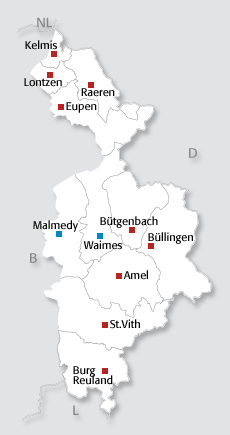Bütgenbach’s history
 Bütgenbach was first mentioned in the 9th century under the Carolingians.
Bütgenbach was first mentioned in the 9th century under the Carolingians.Around 1200, the area around Bütgenbach belonged to the fiefdom of the count of Luxembourg and was allocated to the duke of Limburg in 1214, who married the countess of Luxembourg. The castle of Bütgenbach was constructed on his order in 1237.
Through inheritance, the village is transferred to the house of Falkenburg in 1265.
1461: first mention of ”Wivertz”, ”Wiverhus”, Weywertz
1689: the castle is destroyed by troops of the French king Louis XIV.
1795: the French annexed the area of Bütgenbach, along with the duchy of Luxembourg, the castle is completely destroyed. The area of what is today the community of Bütgenbach is allocated to the Département de l’Ourthe and a smaller part to the Département de la Roer.
With the Vienna Congress of 1915, the region is allocated to the Prussian kingdom. During this time, a military training area is established in Elsenborn.
After World War I, the Contract of Versailles allocates the communities to the kingdom of Belgium. During World War II, from 1940 to 1945, the area of Bütgenbach, along with Eupen-Malmedy, is annexed by the German Reich.
1945: Returned to Belgium.

